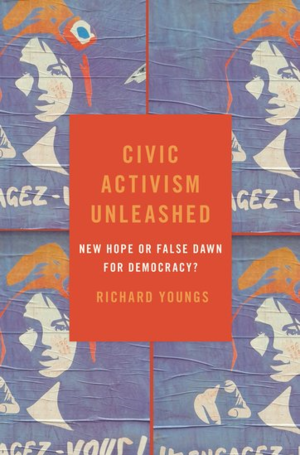“The new forms of protests are part of a global trend”
In his latest book, entitled Civic Activism Unleashed: New Hope or False Dawn for Democracy?, Carnegie scholar Richard Youngs shows how contemporary civic activism has changed globally over the years, focussing on its new forms and recent developments. He also analyses the impact of new civic activism on the civil society itself, using the information gathered on all the main latest protests around the world.

In your book, you are studying new forms of civic activism. When do they emerge and what is new about them?
Different types of civic activism have been around for a long time. Many of the forms we see today are not completely new but we are living through an era where civic activism is much more intense and new forms of activism are spreading on a global basis. The new forms of protest, of local grassroots organizations that we see in the Eastern European region have to be understood as part of a global trend. When we look inside individual countries, we see more intense and frequent protests, we see different kinds of informal civic organisations emerging – a new type of politics often at a local level. These all have national specificities but they are part of what today is a global political trend.
Is there anything specific about this phenomenon in Eastern Europe?
I think that forms of civic activism in every country owe something specific to the local political context. While it is a global trend, what is most interesting and notable is the way that today's civic activism seems to be very firmly rooted in local concerns and issues. A decade or two ago, perhaps the most dynamic area of global civil society were the big international civil society campaigns whereas today we see a lot of activists turning their attention to the very local level. We see this kind of locally rooted activism emerging in very different countries from Russia to Ukraine and Belarus. In each of these countries’, activists have quite distinctive forms of local preoccupations and local aims. These local forms of civic activism are growing and alongside with that we have the more politicised forms of protests, that as we know have taken place in many Eastern European countries as they have in other countries as well.
We have seen large-scale protests in Armenia last year. The leader of the protest movement, Nikol Pashinyan stressed that this was not a colour revolution. Why was this so important?
Obviously, the geopolitical factors that drove the Euromaidan revolt are very different from the geopolitical situation that Armenia finds itself in. So there was not the same kind of geopolitical pulse behind the protests in Armenia. The country had been going through a cycle of several protests over a number of years that gradually accumulated sufficient momentum to have a significant political impact. Initially many of the protests focused on quite specific policy issues rather than being aimed at overturning the government. It took them a number of years to build up a degree of momentum. The other thing for which the Armenia case is interesting is to analyse what happened after the protests in Eastern Europe and indeed more globally. What we often see is the protests being quite high profile, having quite a big impact, but their momentum evaporating quite quickly afterwards because the protesters are not able to formulate political strategies. They are not able to move into mainstream politics. At the moment, it looks as if that in fact has happened in Armenia. But it poses many very difficult challenges and they're the kind of challenges that a country like Armenia is grappling with at the moment: How do you balance civic activism with mainstream political party activity?
Why do some protest movements succeed while others fail?
My book has a long chapter trying to analyse this. If you look around the world, some of the biggest protests have failed whereas those involving smaller numbers have perhaps been more successful. Some of the protests taking place in the most closed, repressive regimes have succeeded while those in slightly more open countries have not. In short, it really isn't easy to identify any single factor. You need to look in detail at the local political context, the tactics chosen and deployed by activists, and also, how the new forms of civic activism relate to the more traditional forms of civil society activities and to mainstream politics. In the book’s analysis, this last factor seems to emerge as a very important variable.
What are the implications for international political or institutional actors?
Institutional actors like the German government, the European Union, and a lot of private foundations pump millions and millions of euros and dollars into supporting civil society around the world every year but they still tend to promote rather old style, formalized civil society organizations. These kind of donors recognize there is a new form of civic activism emerging. Although they have tried to build up some kind of engagement with these new civil society actors, it is proving quite challenging. The book’s conclusion is that the potential offered by these new forms of civic activism is not yet sufficiently on the radar screens of the international community. The new forms of activism are in general not looking for the same kind of engagement with international actors. Now it’s up to the international community to take these new forms of activism seriously but also to redefine the way they themselves engage with civil society.
The interview was conducted by Stefanie Orphal, communications director at ZOiS.
Richard Youngs is a senior fellow in the Democracy, Conflict, and Governance Program, based at Carnegie Europe. He works on EU foreign policy and on issues of international democracy.
Richard Youngs (2019): Civic Activism Unleashed: New Hope or False Dawn for Democracy? Oxford University Press.